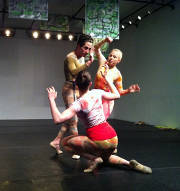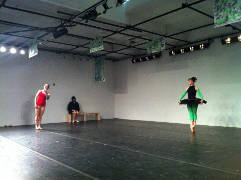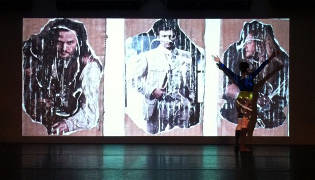
Arts Mixtape
Philip W. Sandstrom
|
Julia K. Gleich explores the interaction of brain
areas and movement. this is a study as much as it is a dance; it explores
the what ifs of how the different areas of the brain affect movement
and how we perceive movement as an audience. By challenging memory
and forcing interaction and using dance as a tool to illuminate the
working of the brain, Gleich stretches the boundaries of neurological
studies.
"The Brodmann Areas," a new ballet
from Norte Maar, produced by Jason Andrew, directed and choreographed
by Julia K. Gleich, musical direction by Ryan Francis, décor
and costumes by Tamara Gonzales, with collaborating artists: Paul
D’Agostino, Lawrence Swan, Denis Pelli, Audra Wolowiec, Margo
Wolowiec and Ian Colletti. Danced by Dylan Crossman, Michelle Buckley,
Jace Coronado,Morgan McEwen, and Abbey Roesner. Philip Sandstrom: How did you become interested in the Brodmann areas? Julia K. Gleich: I skyped into a meeting of Bushwick artists to discuss collaborating on the new piece, some have continued to work with us, and some who just participated in the early discussions. I brought up the idea of emotion versus mathematics, someone else brought up the amygdala, we talked to Mean Humphries, part of her job relates to neuroscience, and Paul D'Agostino, a wonder of knowledge. He brought up one of the Brodmann areas and it's function, so we started investigating it. This guy, Korbinian Brodmann, made a map of the cerebral cortex, the gray matter that is a thin covering on the brain (see http://en.wikipedia.org/wiki/Korbinian_Brodmann). He mapped this covering into 52 areas, according to it's functions, you can look at the charts where all the areas are numbered and indentified, such as sexuality, hearing, vision, etc. It's a compartmentalization of the mind what it means to be thinking. PS: This is based on actual proven science? JG: Yes, these are terms used by neuroscientists. PS: These areas are on the surface of the brain?
JK: Yes, the cerebral cortex is what makes us most human; it's what gives us consciousness. It's a thin, seven or eight layer grey matter area that covers the brain. It's so crinkly, because when we became social beings, that part of our brain had to expand very quickly, and our skull size didn't change quick enough, so the crinkles are a way to create more surface area. Caveat, in the dance where not making a statement as to whether neuroscience is good or bad; there's a whole philosophical debate about it. We're just throwing around some of the ideas (having to do with Brodmann areas). PS: So, what does the dance have to do with any of this? JK: What the dance has become is a collage, and it's (the study of the Brodmann areas) is a sort of glue that sticks it together, with these people on a journey, and these experiments that happen on their journey. PS: Explain what the glue is again? JK: The glue has become the structure of the dance. We have these three people on a journey and then I interrupt that with a series of movement experiments around certain ideas. For example, Denis Pelli, who specializes in peripheral vision at NYU, we're doing a little extract on peripheral vision, and it's a very strange process, we're taking a clinical experience and putting it into a dance setting. PS: And that's one of the 52 Brodmann areas that you examine?
JK: It pertains to, the problem is, you can't really compartmentalize the Brodmann areas because they all interrelate. We're not separating them out (in the dance); if you actually look at them, you see that their functions regularly overlap. PS: Would you send me the website that you've used as reference and
I'll post the link. JK: In true Norte Maar fashion, this is as much fun as it is random in-depth investigation because in the end it's art, it's dance. PS: Are the Brodmann areas a starting point or a reference point for each section that you create? JK: It's a little of both. And you know what, it's a little had to make anything that wouldn't connect with the mind. PS: But it (using the idea of the Brodmann areas) is not simply a publicity stunt? JK: No, no, I'll give you the example of Michelle Buckley doing the Pi dance. (When I was) choreographing a piece in England about the English Reformation, and I remember all the information about the English Reformation now because I choreographed it because once it's put into movement I seem to understand it and remember it better. So, I thought what would I like to memorize that I really can't memorize very well? An of course in terms of the brain, seven digits is the limit of working memory, in terms of memorization. So when we came up with pi, we created a structure, for each digit zero to nine, and we created a dance that is currently 200 decimal places. Consequently, Michelle remembers pi because of the movement. PS: You mean 3.1416 etc.? JK: Yes, so far up to 200 decimal places, because of the movement… PS: She remembers 200 digits? JK: She doesn't actually remember the digits, she remembers the movement and that tells her the digits. PS: As she dances, as she remembers the dance, she recalls the digits? JK: That's right. It's a process of encoding, about storage, and about memory. It deals with all those higher brain function issues. PS: So she can't just rattle off the digits but if she's dancing the pi dance then she can call out the digits?
JK: That's right. She can sit down and visualize the movement and read off the numbers that way, but she has to actually visualize the movement to actually be able to do it. And there's no way she can read out the digits without the movement. It really drives home the idea that pi is irrational because the movement doesn't seem to have any rhyme or reason to it. You'll see things that are related but there is no repetition, no science of patterning; it's very weird. PS: Let's jump to the process, how did you create the movement for this piece? JK: I know when I come out here (to New York from London; where Gleich lives and works at the Laban Institute) that it's going to be a quick three week process so I workshop some of the movement in advance. So, I have material that I can quickly set on the dancers and then build from there. Sometimes I work with music and it's intentions… PS: Is this music that was created for you, for this particular work? JK: Ryan Francis is our musical director, he's making what he calls a meta-piece, where he's select music from a wide range of sources, some of which he has written and includes some Bushwick artists like Ian Colletti, composer. Some of the movement is dancey-dance and some is less so. PS: Define less dancey-dance. JK: Very post-modern, very gestural, a large memory section is gestural where Lawrence Swan will be reciting text, telling us some of the issues that come up regarding the Brodmann areas. PS: he'll be reciting live? PS: Let's go back to dancey-dance vs. gesture. By dancey-dance, you mean dance to music or typical ballet steps? (Gleich is a ballet teacher and practitioner). In other words, what's the vocabulary of the dancey-dance? JK: This is the label problem. Somebody asked me "what are you going to see"? I said you're going to see stuff that looks like contemporary dance and stuff that doesn't look like contemporary dance and stuff that looks like ballet and stuff that doesn't look like ballet. As I was working yesterday on one of the sections, I'm interested in the impetus of movement, an honesty of what initiates movement and the weight of your body in space. This is a modern dance idea, but I notice that dancers who are trained what to finish everything. PS: How do you mean finish everything? JK: Make everything nice and pretty. If I ask them to fall they want to finish the fall with some sort of undulation through the body. PS: They want to look good. JK: They want to look good. And I don't need them to try to look good, because they already look good. In a way they try to mask the truth of how they move…or the rawness, they over think how to connect one thing to the next. Instead of letting the body try to find that pathway by itself. PS: When I think of impetus, I think of the initial force that makes
the body begin to move… PS: Not finishing the form? Do you mean finishing the form would be like the dancers wanting to finish their fall in a beautiful manner? JK: Yes, but for example sometimes arms are up; everybody wants to finish it, I'm more interested in the sense of up. The up-ness. This is an effort to try to describe what it is that I create in terms of the movement. PS: Let's go back to the process, you create chunks of movement in the U.K. and you bring those chunks here… where does it go from there? JK: So, I laid out the glue… we have a section that could be complete from beginning to end, that is based on a series of paintings by Jack Tworkov, of people falling in space together, the paintings are called "House of the Sun". The people are tangled up together; it's a metaphor for life. You're tumbling through the universe. PS: you bring in x amount of material and there's more material you have to create… JK: I spend a lot of time reading about the brain, because I was curious about what's the point in working with movement from this idea of brain function or thinking or the mind. There are all these questions of consciousness, which are implicit in some of the material. But then there are these really obvious ideas about spatial neglect, when a person has a lesion on their parietal lobe; sometimes this is caused by a stroke. They have no consciousness about one side of their body, it (that side) works it functions everything is perfectly normal about it, but if they are asked to talk about it, they don't, they can't, its if it's not there. If you ask them to draw a clock, they'll draw the numbers on one side, they won't draw the numbers on the other side. They'll eat a meal, they'll eat half of the food on the plate, splitting it right down the middle, so if you turn the plate around they only then notice the rest of the food. It (spatial neglect) was perfect for making dance, what an interesting idea if you have to deny one side of the body. PS: Will that be a program note or entry; spatial neglect? JK: Yes, I will outline all of it. I think people will need a little bit of information. PS: It's all very helpful, many times as an audience member I feel lost… JK: Too me, it's fun. Making "Spatial Neglect" (the title of a section of the dance) was fun; it was interesting. It's not dark, I'm not trying to look at the trauma of life. I've chosen to express some of the issues about the brain that are thoughtful; you can go away and ponder it. PS: So, it's the idea not the music that allows you to move forward from the original chunks that you've created in the U.K.? JK: It's not been the music, no, well not in every case. In some cases yes in some cases no. Sometimes we really work with the impetus in the music to make the dance. Most of the time it (the dance) has been built around these (brain study) specific ideas they we've been engaging with. The "House of the Sun" sections, was originally make to (the music of) Stefan Wolpe, we're actually not going to use that score, we decided we're going to use a different linking device now. Because in the journey of the piece the music is not the key thing, it's the idea of these people who are traveling in time and space. PS: I'm still returning to the process. Ok, I'm one of your dancers, you show me the movement that you've created in the U.K.; how do we move forward? JK: The reason I'm struggling to answer that, is that I've created so many different approaches to creating movement for this piece. I haven't relied on one of my typical approaches; which is put on the music and let the music tell me what the ride is…. I made a short duet which is based on some of the from the English Reformation, it's not based in music, it's based on creating an emotional relationship between two people, and then what we've done, using the Brodmann area idea, where different emotions are resident, each dancer has had to chose a different emotion. PS: While they do the movement that you've created for them… JK: We will then show the version of this duet with this different emotion laid on; how does it change it? How does it change the timing and the shape of it. So there's been a lot of process work, a lot of looking at intention, rather than focusing on the pointed foot. That being said, that duet is very balletic. If you think about the Brodmann areas, you have so many different brain functions and ways of thinking, and ways of processing. I've really tried to tap into those different ways that the brain works. And that's why I'm having a difficult time to identify any one way that I work on this piece. PS: Let's jump to the collaborators; this is called A Collaborative Ballet in the title of the press release. That's the visuals and the composition? JK: There's Ryan Francis, who's really stepped into to not only structure the music and chose the music but also he creates the order, he's trying to affect how we link things together in terms of the sound. He's also making that meta-piece… PS: Tell me about the meta-piece one more time? JK: He (Francis) creates a meta-piece through curated selection, then he gets me input and then we alter it according to our mutual satisfaction; that's how were working towards the evening structure. PS: Are the music selections interchangeable? Can different music come at different points in the show? Or are they set? JK: That's funny, I did have this idea that we could make the evening different every night; rearrange the order. We're not going to do that. But theoretically a lot of it could go into different places. PS: and the visuals… JK: We have Tamara Gonzales, she's doing costume design and décor; she works with spray paint and uses lace and other kinds of objects to create edges. Her work is on exhibition at Norte Maar right now. I just want to say this. It's all a huge risk, and every one that we work with has to be willing to say, look this could crash and burn, because we do it quickly and there are very few ideas that we reject. |
| museums | NYTW mail | recordings | coupons | publications | classified |




